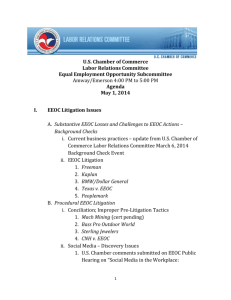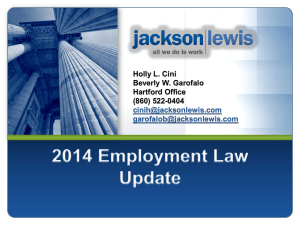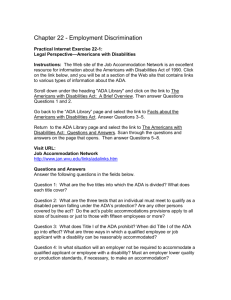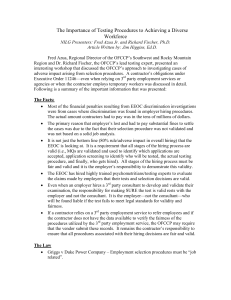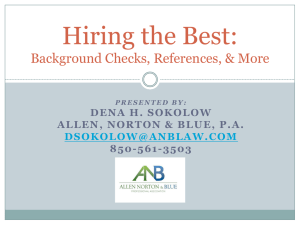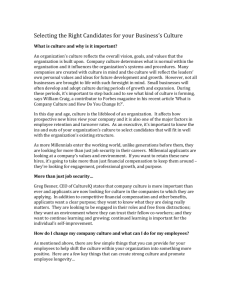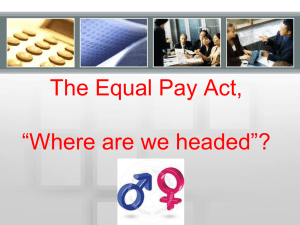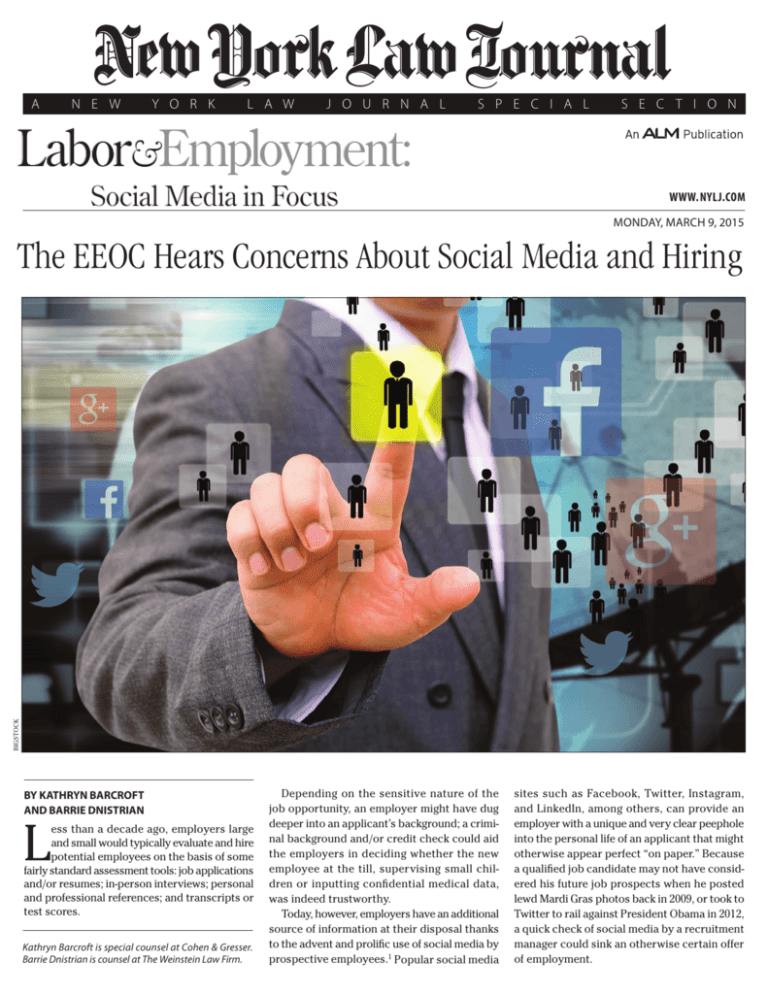
Trends in Antitrust Law
A
N E W
Y O R K
L A W
J O U R N A L
S P E C I A L
Labor&Employment:
Social Media in Focus
S E C T I O N
www. NYLJ.com
monday, march 9, 2015
BIGSTOCK
The EEOC Hears Concerns About Social Media and Hiring
By Kathryn Barcroft
and Barrie Dnistrian
L
ess than a decade ago, employers large
and small would typically evaluate and hire
potential employees on the basis of some
fairly standard assessment tools: job applications
and/or resumes; in-person interviews; personal
and professional references; and transcripts or
test scores.
Kathryn Barcroft is special counsel at Cohen & Gresser.
Barrie Dnistrian is counsel at The Weinstein Law Firm.
Depending on the sensitive nature of the
job opportunity, an employer might have dug
deeper into an applicant’s background; a criminal background and/or credit check could aid
the employers in deciding whether the new
employee at the till, supervising small children or inputting confidential medical data,
was indeed trustworthy.
Today, however, employers have an additional
source of information at their disposal thanks
to the advent and prolific use of social media by
prospective employees.1 Popular social media
sites such as Facebook, Twitter, Instagram,
and LinkedIn, among others, can provide an
employer with a unique and very clear peephole
into the personal life of an applicant that might
otherwise appear perfect “on paper.” Because
a qualified job candidate may not have considered his future job prospects when he posted
lewd Mardi Gras photos back in 2009, or took to
Twitter to rail against President Obama in 2012,
a quick check of social media by a recruitment
manager could sink an otherwise certain offer
of employment.
monday, march 9, 2015
While social media sites are useful tools for an
employer seeking to screen job applicants on the
basis of “organizational fit” or professional connections, for instance, the wealth of additional
information available on those very same sites
may turn the tool into a double-edged (and discriminatory) sword. For example, an applicant’s
social media profile may not only reveal his philanthropic nature and stellar communication skills,
but also his membership in a “protected class.”
Even a cursory review of an applicant’s biographical information on Facebook or vacation photos
on Instagram can readily disclose the applicant’s
race, gender, national origin, color, religion, age,
disability, or marital status. Because federal, state
and local anti-discrimination statutes prohibit
covered employers from making employment
decisions on the basis of an applicant’s protected
class status (including those made in connection
with recruitment and hiring),2 an employer’s use
of social media as a screening tool may trigger
claims of disparate treatment and/or disparate
impact by rejected candidates.3
For this reason, among others, the U.S. Equal
Employment Opportunity Commission (EEOC or
Commission) convened a meeting on March 12,
2014 to gather information regarding the use of
social media and its impact on the federal laws
enforced by the Commission. In a release dated
March 12, 2014, the Commission acknowledged
that the “use of social media has become pervasive in today’s workplace” and that the meeting
“helped the EEOC understand how social media is
being used in the employment context and what
impact it may have on the laws we enforce and
on our mission to stop and remedy discriminatory practices in the workplace.”4
According to a survey published by the Society for Human Resource Management (SHRM)
in 2013, 77 percent of the companies surveyed
reported using social networking sites to recruit
job candidates—a figure that more than doubled
since 2008. While significant in number, only 20
percent of the companies surveyed by SHRM
also use social media to screen (or background
check) job applicants. The substantial dichotomy
in these figures is likely attributable to the potential legal risks perceived by employers who use
social media; in fact, 74 percent of the surveyed
organizations admitted that they avoid screening
applicants in this manner for fear of “discovering information about protected characteristics
… when perusing candidates’ social profiles.”5
Employers should be cautious in their use
of social media for screening purposes in light
of the testimony given during the March 12th
meeting, and the fact that technology changes
faster than the law. To this point, EEOC’s acting
associate legal counsel, cited an EEOC letter
dated May 15, 2012, which acknowledged that
although “the EEO laws do not address the legality per se” of employers requesting passwords
and accessing applicants’ social networks, the
EEOC’s position is clear: “covered employees
must not use personal information from social
networks to make employment decisions on
a prohibited basis, be it race, color, religion,
national origin, sex, age, disability, or protected
genetic information.” For example, “rejecting an
applicant because he is Muslim, as disclosed
through social media postings, would violate
Title VII of the Civil Rights Act of 1964 … Similarly, rejecting an individual with a family history
of breast cancer, as shown in the caption to a
photo of her completing the “Race for the Cure”
in memory of her sister … would violate the
Genetic Information Nondiscrimination Act.”6
Employers should be cautious
in their use of social media for
screening purposes in light of
the testimony given during the
March 12th meeting, and the
fact that technology changes
faster than the law.
Because employers are using social media to
supplement traditional hiring practices and thus,
must comply with a hodgepodge of old and new
laws at the federal and state level, testimony was
provided to the EEOC regarding the most practical ways for employers to avoid the legal pitfalls
of screening applicants via social media.7 As the
EEOC highlighted in its release, these compliance tips include, among others: the selection
of a third-party or designated person within the
company who lacks hiring authority to conduct
the social media background checks on applicants; the use of publicly available information
only; and avoiding requests for passwords or
usernames from job applicants.
In connection with requests by employers
that job applicants provide their social media
usernames and passwords, the EEOC release
noted that at least four states already prohibit
such requests and that similar legislation is
pending at the state and federal levels. Impor-
tantly, this numbers was much higher by the
end of 2014. According to a report issued by
SHRM in August 2014, at least 18 states had
either passed or enacted laws barring requests
for access to employees and job applicants’
social media accounts, and at least 28 states had
similar legislation either introduced or pending.8
In New York, Assembly bill No. A04388, which
would prohibit employers from requesting or
requiring username and login information as a
condition of hiring, is currently before the State
Assembly Labor Committee.9
Federal password protection legislation has
not fared as well. In 2013, the Password Protection Act was introduced in Congress, but failed to
make it out of committee.10 Similarly, the Social
Networking Online Protection Act (or SNOPA)
was introduced in the House of Representatives
in 2012 and 2013, but also stalled once referred
to committee.11 Nevertheless, other federal
statutes address similar privacy concerns and
employers should be aware of them before peering into an applicant’s non-public social media
account. For instance, if employers choose to
designate a company employee or a third-party
entity to review the social media profiles of job
candidates, as was suggested to the EEOC, the
Stored Communications Act of 1986 (SCA)12 and
the Fair Credit Reporting Act (FRCA)13 are likely
implicated. The SCA prohibits intentional access
of electronic communications services (including social media sites) without authorization
and thus, prohibits employers from accessing
an applicant’s private social media.14 In addition,
the FCRA requires any employer that conducts
a background check (or through a consumer
reporting agency to first provide notice to the
applicant that a background check will take
place, obtain consent from the applicant to
conduct a background check, provide notice to
the applicant that information having a negative
impact on the applicant’s eligibility for employment has been found, and allow the applicant
time to correct any incorrect information found
in the consumer report.15 Because employee
background checks can include information
obtained from a host of sources, including social
media, these same rules apply.16
The EEOC release reiterated the point raised
by several panelists during the March 12th
meeting—namely, that the use of social media
in the hiring process can “provide a valuable
tool for identifying good candidates by searching for specific qualifications.” However, in using
social media to screen candidates, employers
must remain mindful of applicable state, federal
monday, march 9, 2015
and local laws and that “the improper use of
information obtained from such sites may be
discriminatory” since protected class status “can
be discerned from information on these sites.”
Case Law Overview
Case law addressing claims of discrimination
due to improper use of social media during the
hiring process has been slow to emerge, ostensibly due to the “newness” of the medium’s use in
the employment context. However, as exemplified below, the claims that have been brought in
several federal courts and before the EEOC tend
to focus on the employer’s discriminatory use of
social media in choosing between job applicants.
In Gaskell v. Univ. of Kentucky,17 a district court
in Kentucky analyzed a claim of discriminatory
hiring by a university that had gathered and used
information from social media Internet searches
during its vetting of candidates for a newly created position. Based on the facts presented, the
court determined that the plaintiff presented sufficient evidence of a Title VII violation based on
the defendant’s refusal to hire and denied the
defendant’s motion for summary judgment.18 As
the court noted, there was no dispute that the
plaintiff, Gaskell, was a leading candidate for the
position, or that during the hiring process, one
of the university’s hiring committee members
conducted a search of social media. The search
led to a link on Gaskell’s website that contained an
article referencing certain conservative religious
beliefs. Because Title VII protects against unlawful
employment practices, including discrimination
against an individual “with respect to compensation, terms, conditions, or privileges of employment, because of such individual’s … religion,”19
the court found that sufficient evidence existed
to create a triable issue of fact as to whether
the search committee evaluated candidates for
employment on the basis of illegal criteria and
whether plaintiff’s “religious beliefs were a substantial motivating factor in [the university’s]
decision not to hire him.”
In Nieman v. Grange Mutual Ins.,20 a federal
district court in Illinois analyzed a job applicant’s
claim that a prospective employer discriminated
against him in violation of the ADEA on the basis
of a social media search conducted during the
hiring process that revealed his age.21 Specifically, the pro se plaintiff claimed that the company rejected his application for employment
because the human resources department had
actual knowledge of his age based on his LinkedIn profile, which included his college graduation date. The court ultimately determined that
the plaintiff presented sufficient evidence of age
discrimination to survive a motion to dismiss.
The take away from this case, in keeping with
the testimony provided to the EEOC, is that an
employer’s use of social media to disqualify a
candidate on a protected class basis could serve
as evidence against an employer charged with
employment discrimination.
In Reese v. Salazar, Sec’y, Dep’t of Interior,22
the EEOC addressed the issue of social media
and discrimination in employee recruitment.
The plaintiff, alleging violations of the ADEA
and Title VII by a government agency, claimed
that she was not selected for a Park Ranger
position due to her age (61) and sex (female),
and that, generally, the agency’s use of social
media for recruitment had a disparate impact
on older workers because they used computers less frequently than younger people. The
Administrative Judge analyzed the disparate
treatment claim and found that while the complainant alleged a prima facie case of age and
sex discrimination, the agency articulated a
legitimate, nondiscriminatory reason for its
action. The Administrative Judge also found
that the plaintiff failed to present evidence
that social media was the exclusive means
for recruitment by the agency and that no
prima facie case of disparate impact existed
because “an analysis of the data showed that
there was no significant disparity based on
the number of applicants in each age bracket.”
These determinations were upheld on appeal.
In Brief
Like any new technology, the law needs time
to play catch-up with its impact on individual
rights. As these cases demonstrate, and as the
EEOC reiterated in its press release, “the EEO
laws do not expressly permit or prohibit use of
specified technologies … . The key question …
is how the selection tools are used.”
••••••••••••••••
•••••••••••••
1. An estimated 1.35 billion users access Facebook on a
monthly basis. As of December 2014, Instagram and Twitter
boast 300 million and 284 million monthly users, respectively.
John Constine, “Instagram Hits 300 Million Monthly Users to
Surpass Twitter, Keeps It Real With Verified Badges,” TechCrunch, Dec. 10, 2014, http://techcrunch.com/2014/12/10/
not-a-fad/.
2. Federal laws that prohibit discriminatory practices in the
recruitment and hiring of employees include Title VII of the Civil
Rights Act of 1964 (Title VII), the Americans with Disabilities Act
(ADA), the Genetic Information Nondiscrimination Act of 2008,
and the Age Discrimination in Employment Act of 1967 (ADEA).
Additional federal laws not enforced by the EEOC also proscribe
discriminatory practices in the hiring and employment context.
See EEOC, “Federal Laws Prohibiting Job Discrimination, Questions and Answers,” http://www.eeoc.gov/facts/qanda.html.
Many states and municipalities, including New York and New
York City, have similar anti-discrimination laws. See, e.g., New
York State Human Rights Law, N.Y. Exec. Law §296; New York
City Human Rights Law, N.Y. Admin. Code §8-107(1).
3. For example, an employer’s use of an applicant’s membership in a protected class as a basis to disqualify him or her
from employment may give rise to a disparate treatment claim.
An employer’s use of targeted advertising on a social media
site to recruit job candidates from a specific group (such as
men only or individuals under the age of 40) may give rise to
claims of disparate impact.
4. See EEOC, Press Release, “Social Media is Part of Today’s
Workplace but its Use May Raise Employment Discrimination
Concerns,” March 12, 2014, http://www.eeoc.gov/eeoc/newsroom/release/3-12-14.cfm.
5. See Written Testimony of Jonathan Segal, Partner, Duane
Morris; Managing Principal, Duane Morris Institute testifying
on behalf of the Society of Human Resource Management, at
pp.2-3, http://www.eeoc.gov/eeoc/meetings/3-12-14/segal.cfm.
6. See Written Testimony of Carol R. Miaskoff, Acting Associate Legal Counsel, EEOC, at p.3, http://www1.eeoc.gov//eeoc/
meetings/1-14-15/miaskoff.cfm?renderforprint=1. The May 15,
2012 letter referred to by Ms. Miaskoff was an EEOC response to
an inquiry by Sens. Charles E. Schumer and Richard Blumenthal
regarding the legality of employers requiring job applicants to
provide their social media usernames and passwords as part of
the hiring process. Id.
7. See Written Testimony of Renee Jackson, Associate, Nixon
Peabody, at p.3, http://www.eeoc.gov/eeoc/meetings/3-12-14/
jackson.cfm.
8. Aliah D. Wright, “More States Ban Social Media Snooping,”
Society of Human Resource Management, Aug. 12, 2014, http://
www.shrm.org/hrdisciplines/technology/articles/pages/social-media-snooping.aspx.
9. New York Assembly, 2015-2016 reg. sess. A04388.
10. Password Protection Act of 2013, H.R. 2077, 113th Cong.;
Password Protection Act of 2013, S. 1426, 113th Cong.
11. Social Networking Online Protection Act, H.R. 5050,
112th Cong. (2012); Social Networking Online Protection Act,
H.R. 537, 113th Cong. §2(a) (2013).
12. 18 U.S.C. §2701 et seq. (1986).
13. 15 U.S.C. §1681 et seq. (1970).
14. See Pietrylo v. Hillstone Restaurant Group, Civ. Case No.
06-5754, 2009 WL 3128420 (D.N.J. Sept. 25, 2009) (employer violated SCA by knowingly accessing a password-protected chatgroup on social networking website without authorization);
see also Ehling v. Monmouth-Ocean Hosp. Service, 872 F. Supp.
2d 369 (D.N.J. 2012) (finding SCA will apply to Facebook postings marked “private” because they are (1) electronic communications, (2) transmitted via an electronic communication
service, and (3) are in electronic storage).
15. Federal Trade Commission, “Using Consumer Reports:
What Employers Need to Know,” January 2012.
16. Lesley Fair, “The Fair Credit Reporting Act & social media: What businesses should know,” Federal Trade Commission, June 23, 2011, http://www.ftc.gov/news-events/blogs/
business-blog/2011/06/fair-credit-reporting-act-social-mediawhat-businesses. see also, e.g., Maneesha Mithal, FTC, Social
Intelligence Corp., Letter to Renee Peabody, May 9, 2011,
http://www.ftc.gov/sites/default/files/documents/closing_letters/social-intelligence-corporation/110509socialintelligence
letter.pdf (“Consumer reporting agencies must comply with
several different FCRA provisions, and these compliance obligations apply equally in the social networking context.”).
17. Gaskell v. Univ. of Kentucky, Civ. A. No. 09-244-KSF, 2010
WL 4867630 (E.D. Ky. Nov. 23, 2010).
18. 42 U.S.C. §2000e et seq., as amended.
19. 42 U.S.C. § 2000e-2(a)(1).
20. Nieman v. Grange Mutual Ins., No. 11-3403, 2013 WL
1332198 (C.D. Ill. April 2, 2013).
21. 29 U.S.C. §621 et seq.
22. Reese v. Salazar, Sec’y, Dep’t of Interior, Slip. Op.
EEOC Agency No. NPS100602 (May 3, 2012) and Appeal No.
0120122339 (Nov. 15, 2012), available at http://www.eeoc.gov/
decisions/0120122339.txt.
Reprinted with permission from the March 9, 2015 edition of the NEW YORK
LAW JOURNAL © 2015 ALM Media Properties, LLC. All rights reserved. Further
duplication without permission is prohibited. For information, contact 877-257-3382
or reprints@alm.com. # 070-03-15-30

